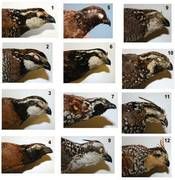
Bobwhite Quail Genetics Across the Western Hemisphere

Most Texans are well-acquainted with the Northern Bobwhite, a valued game bird in much of the eastern United States. Few, however, are aware that the historical range of the Northern Bobwhite includes much of Mexico and northern Guatemala or that other “kinds” of bobwhites also occur within this region.
For example, there are two tropical relatives of bobwhites, the Black-throated and Crested bobwhites. The Black-throated Bobwhite occurs in scattered localities in the Yucatán Peninsula, eastern Nicaragua and eastern Honduras. The Crested Bobwhite
ranges from the Pacific coast of Central America to northern Brazil.
All three species of bobwhites display differences in plumage coloration throughout their extensive geographic range, and this variation is one reason why early taxonomists identified these variants as distinct subspecies or geographic variants. The Northern Bobwhite alone consists of 19 subspecies, one (masked bobwhite) of which is considered endangered. The Crested Bobwhite is divided into 20 subspecies, and four subspecies are recognized for the Black-throated Bobwhite.
Our recent study employed a genetic approach designed to investigate previous patterns of geographic variation defined based on morphology. In an effort to examine broad scale patterns of geographic variation for all species and most subspecies of bobwhites in the Americas, we used ancient DNA extracted from
several hundred museum specimens collected between 1870 and 1989. Surprisingly, the overall taxonomic diversity identified in the late 19th and early 20th centuries failed to be upheld by patterns of genetic variation. Rather than a host of subspecies for each defined species (Northern Bobwhite, Black-throated Bobwhite and Crested Bobwhite), two deeply divergent groups were identified.
One group consisted of the northern and Black-throated Bobwhites and the other represented by the Crested Bobwhite. Based on dating from our genetic data, this split occurred 3-5 million years ago and was probably the result of geological events
occurring at this time in southern Mexico. Despite previous speculation that the Black-throated Bobwhite was a subspecies of the Northern Bobwhite, our data support the view that these birds are actually separate species.
Even though the Northern Bobwhite is broadly distributed, has limited dispersal capabilities and is subject to boom-bust periods of population fluctuations, there is little genetic evidence for these factors resulting in distinct genetic units. This is the case even for the Cuban and Masked bobwhites.
Of the three described species of bobwhites, the Crested Bobwhite displayed the greatest genetic differentiation, defined by four distinct groups. At the same time, these groups do not coincide with classically recognized subspecies. Our results
support the current species designations of Northern, Black-throated, and Crested bobwhites. Our results also suggest that conservation and management of the three should be focused on geographic regions rather than subspecies.
